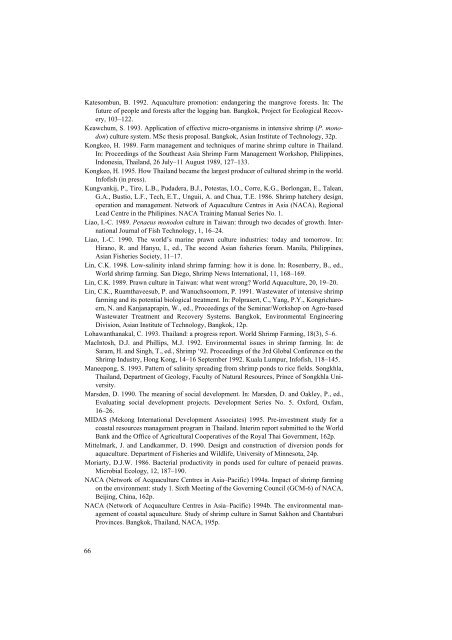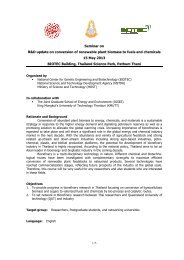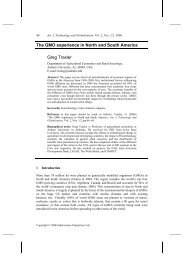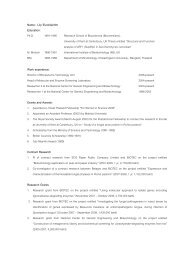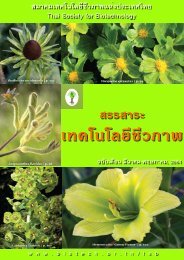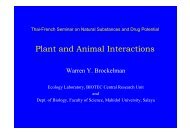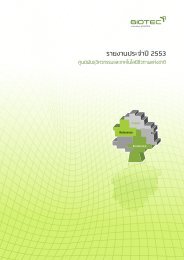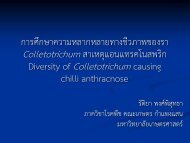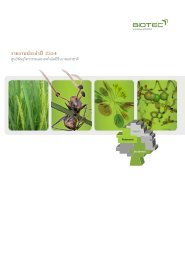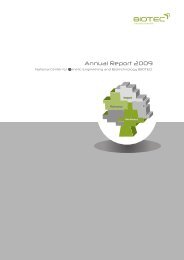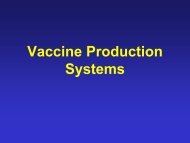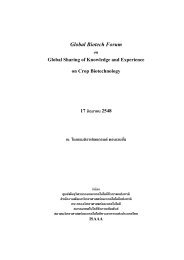Katesombun, B. 1992. <strong>Aquaculture</strong> promotion: endanger<strong>in</strong>g the mangrove <strong>for</strong>ests. In: Thefuture of people and <strong>for</strong>ests after the logg<strong>in</strong>g ban. Bangkok, Project <strong>for</strong> Ecological Recovery,103–122.Keawchum, S. 1993. Application of effective micro-organisms <strong>in</strong> <strong>in</strong>tensive shrimp (P. monodon)culture system. MSc thesis proposal. Bangkok, Asian Institute of Technology, 32p.Kongkeo, H. 1989. Farm management and techniques of mar<strong>in</strong>e shrimp culture <strong>in</strong> <strong>Thailand</strong>.In: Proceed<strong>in</strong>gs of the Southeast Asia <strong>Shrimp</strong> Farm Management Workshop, Philipp<strong>in</strong>es,Indonesia, <strong>Thailand</strong>, 26 July–11 August 1989, 127–133.Kongkeo, H. 1995. How <strong>Thailand</strong> became the largest producer of cultured shrimp <strong>in</strong> the world.Infofish (<strong>in</strong> press).Kungvankij, P., Tiro, L.B., Pudadera, B.J., Potestas, I.O., Corre, K.G., Borlongan, E., Talean,G.A., Bustio, L.F., Tech, E.T., Unguii, A. and Chua, T.E. 1986. <strong>Shrimp</strong> hatchery design,operation and management. Network of <strong>Aquaculture</strong> Centres <strong>in</strong> Asia (NACA), RegionalLead Centre <strong>in</strong> the Philip<strong>in</strong>es. NACA Tra<strong>in</strong><strong>in</strong>g Manual Series No. 1.Liao, I.-C. 1989. Penaeus monodon culture <strong>in</strong> Taiwan: through two decades of growth. InternationalJournal of Fish Technology, 1, 16–24.Liao, I.-C. 1990. The world’s mar<strong>in</strong>e prawn culture <strong>in</strong>dustries: today and tomorrow. In:Hirano, R. and Hanyu, I., ed., The second Asian fisheries <strong>for</strong>um. Manila, Philipp<strong>in</strong>es,Asian Fisheries Society, 11–17.L<strong>in</strong>, C.K. 1998. Low-sal<strong>in</strong>ity <strong>in</strong>land shrimp farm<strong>in</strong>g: how it is done. In: Rosenberry, B., ed.,World shrimp farm<strong>in</strong>g. San Diego, <strong>Shrimp</strong> News International, 11, 168–169.L<strong>in</strong>, C.K. 1989. Prawn culture <strong>in</strong> Taiwan: what went wrong? World <strong>Aquaculture</strong>, 20, 19–20.L<strong>in</strong>, C.K., Ruamthaveesub, P. and Wanuchsoontorn, P. 1991. Wastewater of <strong>in</strong>tensive shrimpfarm<strong>in</strong>g and its potential biological treatment. In: Polprasert, C., Yang, P.Y., Kongricharoern,N. and Kanjanaprap<strong>in</strong>, W., ed., Proceed<strong>in</strong>gs of the Sem<strong>in</strong>ar/Workshop on Agro-basedWastewater Treatment and Recovery Systems. Bangkok, Environmental Eng<strong>in</strong>eer<strong>in</strong>gDivision, Asian Institute of Technology, Bangkok, 12p.Lohawanthanakal, C. 1993. <strong>Thailand</strong>: a progress report. World <strong>Shrimp</strong> Farm<strong>in</strong>g, 18(3), 5–6.MacIntosh, D.J. and Phillips, M.J. 1992. Environmental issues <strong>in</strong> shrimp farm<strong>in</strong>g. In: deSaram, H. and S<strong>in</strong>gh, T., ed., <strong>Shrimp</strong> ‘92. Proceed<strong>in</strong>gs of the 3rd Global Conference on the<strong>Shrimp</strong> Industry, Hong Kong, 14–16 September 1992. Kuala Lumpur, Infofish, 118–145.Maneepong, S. 1993. Pattern of sal<strong>in</strong>ity spread<strong>in</strong>g from shrimp ponds to rice fields. Songkhla,<strong>Thailand</strong>, Department of Geology, Faculty of Natural Resources, Pr<strong>in</strong>ce of Songkhla University.Marsden, D. 1990. The mean<strong>in</strong>g of social development. In: Marsden, D. and Oakley, P., ed.,Evaluat<strong>in</strong>g social development projects. Development Series No. 5. Ox<strong>for</strong>d, Oxfam,16–26.MIDAS (Mekong International Development Associates) 1995. Pre-<strong>in</strong>vestment study <strong>for</strong> acoastal resources management program <strong>in</strong> <strong>Thailand</strong>. Interim report submitted to the WorldBank and the Office of Agricultural Cooperatives of the Royal Thai Government, 162p.Mittelmark, J. and Landkammer, D. 1990. Design and construction of diversion ponds <strong>for</strong>aquaculture. Department of Fisheries and Wildlife, University of M<strong>in</strong>nesota, 24p.Moriarty, D.J.W. 1986. Bacterial productivity <strong>in</strong> ponds used <strong>for</strong> culture of penaeid prawns.Microbial Ecology, 12, 187–190.NACA (Network of Acquaculture Centres <strong>in</strong> Asia–Pacific) 1994a. Impact of shrimp farm<strong>in</strong>gon the environment: study 1. Sixth Meet<strong>in</strong>g of the Govern<strong>in</strong>g Council (GCM-6) of NACA,Beij<strong>in</strong>g, Ch<strong>in</strong>a, 162p.NACA (Network of Acquaculture Centres <strong>in</strong> Asia–Pacific) 1994b. The environmental managementof coastal aquaculture. Study of shrimp culture <strong>in</strong> Samut Sakhon and ChantaburiProv<strong>in</strong>ces. Bangkok, <strong>Thailand</strong>, NACA, 195p.%%
Nakalak, C. 1994. Fishery statistics of <strong>Thailand</strong>. In: Proceed<strong>in</strong>gs of the Regional Workshop onFishery In<strong>for</strong>mation and Statistics <strong>in</strong> Asia, Volume II. Bangkok, Southeast Asian FisheriesDevelopment Center, 261–268.Nash, G., Anderson, I.G. and Shariff, M. 1988. Pathological changes <strong>in</strong> the tiger prawn,Penaeus monodon Fabricius, associated with culture <strong>in</strong> brackishwater ponds developedfrom potentially acid sulphate soils. Journal of Fish Diseases, 11, 113–123.OECF (Overseas Economic Cooperation Fund of Japan) 1992. <strong>Thailand</strong> environmental profile,Volume I. Hels<strong>in</strong>ki, F<strong>in</strong>land, Soil and Water Ltd.OEPP (Office of Environmental Policy and Plann<strong>in</strong>g) 1994. The environmental managementof coastal aquaculture. An assessment of shrimp culture <strong>in</strong> Samut Sakhon and ChantaburiProv<strong>in</strong>ces. Prepared <strong>for</strong> OEPP by the Network of <strong>Aquaculture</strong> Centres <strong>in</strong> Asia–Pacific(NACA). Bangkok, NACA, 195p.Office of Agricultural Economics 1991. The enterprise of giant prawn culture <strong>in</strong> <strong>Thailand</strong>.Agricultural Economics Division Technical Paper, 54, 107p.Office of National Statistics 1990. Report on survey of costs and returns of semi and <strong>in</strong>tensiveshrimp farm<strong>in</strong>g <strong>in</strong> 1990. Office of Prime M<strong>in</strong>ister, 69p.Paw, J.N., Bunapapong, S., White, A.T. and Sadorra, M.S.S. 1988. The coastal environmentprofile of Ban Don Bay and Phangnga Bay, <strong>Thailand</strong>. Association of South-East AsianNations/United States <strong>Coastal</strong> Resources Management Project. Technical PublicationsSeries 2, 75p.Phillips, M.J. 1992. Environmental aspects of shrimp culture <strong>in</strong> <strong>Thailand</strong>. Report <strong>for</strong> the AsianDevelopment Bank Review Mission on Loan No. 787–THA: Brackishwater <strong>Shrimp</strong>Culture Development Project, 11p.Phillips, M.J., Kwei L<strong>in</strong>, C. and Beveridge, M.C.M. 1993. <strong>Shrimp</strong> culture and the environment:lessons from the world’s most rapidly expand<strong>in</strong>g warm water aquaculture sector. In:Pull<strong>in</strong>, R.S.V., Rosenthal, H. and Maclean, J.L., ed., Environment and aquaculture <strong>in</strong>develop<strong>in</strong>g countries. ICLARM (International Centre <strong>for</strong> Liv<strong>in</strong>g Aquatic Resources) ConferenceProceed<strong>in</strong>gs, 31, 171–197.Piamsomboon, S. 1993. <strong>Shrimp</strong> farm<strong>in</strong>g, and advantages <strong>for</strong> socioeconomics. In: A conferenceon the positive impact of shrimp farm<strong>in</strong>g on ecology of coastal water and Thai economics,31 January 1993, Hadkoaw Resort, Songkhla, <strong>Thailand</strong>. <strong>Thailand</strong>, Department of Fisheries,35–62.Poernomo, A. 1990. Site selection <strong>for</strong> coastal shrimp ponds. In: Technical and economicaspects of shrimp farm<strong>in</strong>g. Proceed<strong>in</strong>gs of the Aquatech ‘90 conference, Kuala Lumpur,Malaysia, 11–14 June 1992. Kuala Lumpur, Malaysia, Infofish, 3–19.Pollution Control Department 1997. A survey of water pollution from coastal aquaculture.Report of a study by the Network of <strong>Aquaculture</strong> Centres <strong>in</strong> Asia–Pacific submitted to thePollution Control Department of the M<strong>in</strong>istry of Science and Technology of <strong>Thailand</strong>,Bangkok, 208p.Primavera, J.H. 1989. The social, ecological and economic implications of <strong>in</strong>tensive prawnfarm<strong>in</strong>g. SEAFDEC (Southeast Asian Fisheries Development Center) Asian <strong>Aquaculture</strong>,111, 1–6.Ragunathnan, S. and Hambrey, J.B. 1997. <strong>Thailand</strong>. World shrimp farm<strong>in</strong>g 1996. In: Rosenberry,B., ed., <strong>Shrimp</strong> News International, 79–87.Raksakul, S. 1994. Prawn farm<strong>in</strong>g: riches and ru<strong>in</strong>s. Sunday Post, Bangkok, November 131994, 20–21.Robertson, A. and Phillips, M.J. 1995. Mangroves as filters of shrimp pond effluent: predictionsand biogeochemical research needs. Hydrobiologia, 295, 311–321.Shariff, M. and Subas<strong>in</strong>ghe, R. 1992. Aquarium fish health—do we really care? Infofish International,6, 43–47.%&
- Page 8 and 9:
!The 1994 Workshop had a working hy
- Page 11 and 12:
!The Workshop at Hat Yai, SongkhlaA
- Page 13 and 14:
!ReferenceSmith, P.T., ed.. 1999. T
- Page 15 and 16: !Shrimp Farming in ThailandOver the
- Page 18 and 19: ! !Table 1. World production (# 1,0
- Page 20 and 21: !Domestic and world demandJapan is
- Page 22 and 23: !Intensification of farms has been
- Page 24 and 25: !no significant difference between
- Page 26 and 27: !Production Practices and Technique
- Page 28 and 29: !use water which is almost fresh (F
- Page 30 and 31: !mended quantities for application
- Page 32 and 33: !the biological processes in sedime
- Page 34 and 35: !factors (Fegan 1994). Environmenta
- Page 36 and 37: !Acid sulphate soils occur in most
- Page 38 and 39: during the rainy season, some deter
- Page 40 and 41: Land subsidenceCoastal land subside
- Page 42 and 43: first when an area becomes environm
- Page 44 and 45: !Administration. Their work has inv
- Page 46 and 47: agriculture, selects coastal land p
- Page 48 and 49: Sustainability, Sustainable Develop
- Page 50 and 51: cultural and environmental asset va
- Page 52 and 53: $+Table 12. (cont’d) Impediments
- Page 54 and 55: $#Table 12. (cont’d) Impediments
- Page 56 and 57: $%Table 12. (cont’d) Impediments
- Page 58 and 59: capacities of alternative organisms
- Page 60 and 61: sources. This is one of the greates
- Page 62 and 63: Table 13. (cont’d) Summary of the
- Page 64 and 65: Boonyapiwat, S. 1989. Species of ph
- Page 68 and 69: Sirisup, S. 1988 Socio-economic cha
- Page 70 and 71: !In the preliminary analysis, the s
- Page 72 and 73: !until all variables had been teste
- Page 74 and 75: !quality problem over the past 3 ye
- Page 76 and 77: !Figure 1. Characterisation of prov
- Page 78 and 79: !Variables Contributing to Shrimp P
- Page 80 and 81: !Figure 5. Relationship between ave
- Page 82 and 83: !southern). The linear regression m
- Page 84 and 85: !Appendix. Results of logistic regr
- Page 86 and 87: !2) Trat ProvinceClassification tab
- Page 88 and 89: !Chi-square df significanceModel Ch
- Page 90 and 91: !8) Satun ProvinceClassification ta
- Page 92 and 93: !Variables in the equationConstant
- Page 94 and 95: !A total of 49 participants were in
- Page 96 and 97: ! ! ! ! ! ! ! ! ! ! ! ! ! ! ! ! !Fi
- Page 98 and 99: !All issues are listed in Appendice
- Page 100 and 101: !!were short term and one issue was
- Page 102 and 103: !reared broodstock (issue 71). They
- Page 104 and 105: !!Two participants commented that i
- Page 106 and 107: mation transfer and training. This
- Page 108 and 109: 108Appendix 1. (cont’d) Descripti
- Page 110 and 111: 110Appendix 1. (cont’d) Descripti
- Page 112 and 113: 112Appendix 2. Descriptive statisti
- Page 114 and 115: 114Appendix 2. (cont’d) Descripti
- Page 116 and 117:
116Appendix 3. Descriptive statisti
- Page 118 and 119:
118Appendix 4. Descriptive statisti
- Page 120 and 121:
120Appendix 5. Descriptive statisti
- Page 122 and 123:
Appendix 5. (cont’d) Descriptive
- Page 124 and 125:
Appendix 7. Descriptive statistics
- Page 126 and 127:
Appendix 7. (cont’d) Descriptive
- Page 128 and 129:
128Appendix 8. (cont’d) Descripti
- Page 130 and 131:
!ParticipantsAustraliaDr Paul T. Sm


